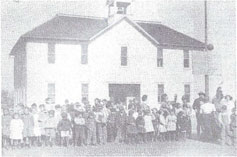This summary about the story of Cassoday, Kansas comes from a document created by Marie Harsh, titled "A History of Cassoday, Kansas"
Small communities, such as Cassoday and Sycamore Springs, have legends, events and people who have helped with the growth and development of these communities. Cassoday is a prairie town that outlived and absorbed Sycamore Springs.It has remained a small town. There has never been an oil boom nor other industrial activities to cause sudden growth. It has developed into a small incorporated town with modem facilities solely through agriculture and the cattle industry.The purpose of this report lies, for the greater part, in a desire to preserve, for those who follow, a part of the legends,events and histories of the families who have lived in the Cassoday community.An invitation was issued for family pictures and data to be compiled by members who have remained in the community. There was only a trickle of material received.In an effort to present a history that covers the entire community, many accounts were written as best they could be by others than members of the families. This was done through research, inquiry and personal knowledge. However, this history includes much that was contributed by those who helped because they hoped for a broad scope telling the community story. All those who have lived in Northeast Butler County will be everlastingly greatful to each contributor for his help in preserving the past of an interesting locality."Thank You," from all who love Cassoday and these beautiful F1int Hills.
·Marie Harsh
Cassoday, Kansas June 10, 1976
Beginning of Cassoday | 1886
Cassoday is located in the northeast quarter of Section 23, Township 23, Range 7, East, on land which was taken by John G. Guthrie May 1, 1869, two years before the township was organized . Ulysses S. Grant, president of the United States, signed the original papers for the land title. In July of 1886, Butler County Commissioners condemned a strip of land across the northwest corner of this townsite as a right-of-way for the Chicago, Kansas and Western Railway Company.
With the promises of a railroad, the building boom began. With a dozen or so homes, and a 2-story hotel, grocery store and general store along with a lumberyard, blacksmith shop and grist mill.
Railroad Came to Cassoday | 1904
Walter W. Colpitto, a civil engineer, surveyed right-of-way for the Kansas City, Mexico and Orient Railway. While the location of the railway had changed slightly, new businesses still sprang up. With a bank, three grocery stores, two doctors, a butcher shop and ice ream parlor, along with a newspaper "Cassoday Times". The First School Building | 1910
The first school building was this four-room structure built in1910. When two years of high school were added, these classes were taught in one of the second-floor rooms.

A thriving community with bright prospects | 1906
"This portion of northern Butler County has been used principally for grazing. Earlier all farms were along creeks; in recent years, farmers, including many from Eastern States,have recognized the rich soil and general lay of the land, as one of the 'garden spots of the earth.'
"All men of enterprise who have faith in the future of this city. They are backing their faith up by works," said the writer in the El Dorado Advocate.
Cattle Industry
Prairie Chicken Capital of the World
Memorable Events of Cassoday
Arthur Capper, later governor of the state and United States Senator, was on the program to lead the grand march with Queen Geneva."Neva" and the late Dwight Harsh lived on their farm near Cassoday. To this union were born a son, Dwayne, and three daughters, Pauline, Lois and Eloise.In 1927, Eloise was chosen maid-of-honor to "Baby Queen,"Roberta Barker of Whitewater at the Kafir Corn Carnival that year.
In 1948, Arthur R. Waits, who lived with his sister, Florence, on their 320-acre farm west of Cassoday had the distinction of being "The Farmer of the Week." Arthur attended Kansas State College at Manhattan and was affiliated with the Butler County Farm Bureau and the National and State Shorthorn Breeders Association. In addition to being a good dirt farmer, he raised registered Shorthorn cattle. His parents and grandparents had farmed in this vicinity.
March 31, 1931, a few miles northeast of Cassoday, on the farm of Seward Baker, in Chase County, an airplane crashed in a pasture, killing all eight occupants. Knute Rockne, coach at Notre Dame University was among those who died there. Rockne had boarded the plane at Kansas City enroute to California. The accident was caused by the plane losing a wing assembly. The assembly was found a half mile from the scene of the crash .A monument, in memory of those who lost their lives was erected at the site. The well-remembered football coach was at the zenith of his career. That muddy day thousands of sports fans, to whom Rockne was a legend in his own time, flocked through Cassoday in an effort to get near the spot where he died.

